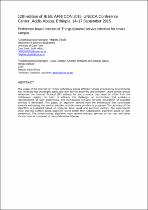JavaScript is disabled for your browser. Some features of this site may not work without it.
- ResearchSpace
- →
- Research Publications/Outputs
- →
- Conference Publications
- →
- View Item
| dc.contributor.author |
Manqele, L

|
|
| dc.contributor.author |
Dlodlo, M

|
|
| dc.contributor.author |
Coetzee, L

|
|
| dc.contributor.author |
Williams, Q

|
|
| dc.contributor.author |
Sibiya, G

|
|
| dc.date.accessioned | 2016-02-23T09:25:20Z | |
| dc.date.available | 2016-02-23T09:25:20Z | |
| dc.date.issued | 2015-09 | |
| dc.identifier.citation | Dlodlo, M, Coetzee, L, Williams, Q and Sibiya, G. 2015. Preference-based Internet of Things dynamic service selection for smart campus. In: 12th edition of IEEE AFRICON 2015, UNECA Conference Center, Addis Ababa, Ethiopia, 14–17 September 2015 | en_US |
| dc.identifier.uri | http://ieeexplore.ieee.org/xpls/abs_all.jsp?arnumber=7332047&tag=1 | |
| dc.identifier.uri | http://hdl.handle.net/10204/8421 | |
| dc.description | 12th edition of IEEE AFRICON 2015, UNECA Conference Center, Addis Ababa, Ethiopia, 14–17 September 2015. Due to copyright restrictions, the attached PDF file only contains the abstract of the full text item. For access to the full text item, please consult the publisher's website | en_US |
| dc.description.abstract | The usage of the Internet of Things technology across different service provisioning environments has increased the challenges associated with service discovery and selection. Users cannot always remember the Internet Protocol (IP) address for every service they need to utilize from the middleware registry. In order to address this challenge, an architecture that enables a representation of user preferences and manipulates relevant services description of available services is developed. This paper, an algorithm derived from the architecture that contributes towards addressing the service selection and discovery problem is proposed. The accuracy of the algorithm is evaluated based on response time, recall and precision metrics. The experiments show that the content-based algorithm works better than collaborative algorithm based on user preference. The content-based algorithm more returns relevant services to the user and takes shorter time as compared to the collaborative filtering. | en_US |
| dc.language.iso | en | en_US |
| dc.publisher | IEEE | en_US |
| dc.relation.ispartofseries | Workflow;15568 | |
| dc.subject | Internet of Things | en_US |
| dc.subject | Service discovery | en_US |
| dc.subject | Service selection | en_US |
| dc.subject | Recommender system | en_US |
| dc.subject | Context-aware algorithm | en_US |
| dc.title | Preference-based Internet of Things dynamic service selection for smart campus | en_US |
| dc.type | Conference Presentation | en_US |
| dc.identifier.apacitation | Manqele, L., Dlodlo, M., Coetzee, L., Williams, Q., & Sibiya, G. (2015). Preference-based Internet of Things dynamic service selection for smart campus. IEEE. http://hdl.handle.net/10204/8421 | en_ZA |
| dc.identifier.chicagocitation | Manqele, L, M Dlodlo, L Coetzee, Q Williams, and G Sibiya. "Preference-based Internet of Things dynamic service selection for smart campus." (2015): http://hdl.handle.net/10204/8421 | en_ZA |
| dc.identifier.vancouvercitation | Manqele L, Dlodlo M, Coetzee L, Williams Q, Sibiya G, Preference-based Internet of Things dynamic service selection for smart campus; IEEE; 2015. http://hdl.handle.net/10204/8421 . | en_ZA |
| dc.identifier.ris | TY - Conference Presentation AU - Manqele, L AU - Dlodlo, M AU - Coetzee, L AU - Williams, Q AU - Sibiya, G AB - The usage of the Internet of Things technology across different service provisioning environments has increased the challenges associated with service discovery and selection. Users cannot always remember the Internet Protocol (IP) address for every service they need to utilize from the middleware registry. In order to address this challenge, an architecture that enables a representation of user preferences and manipulates relevant services description of available services is developed. This paper, an algorithm derived from the architecture that contributes towards addressing the service selection and discovery problem is proposed. The accuracy of the algorithm is evaluated based on response time, recall and precision metrics. The experiments show that the content-based algorithm works better than collaborative algorithm based on user preference. The content-based algorithm more returns relevant services to the user and takes shorter time as compared to the collaborative filtering. DA - 2015-09 DB - ResearchSpace DP - CSIR KW - Internet of Things KW - Service discovery KW - Service selection KW - Recommender system KW - Context-aware algorithm LK - https://researchspace.csir.co.za PY - 2015 T1 - Preference-based Internet of Things dynamic service selection for smart campus TI - Preference-based Internet of Things dynamic service selection for smart campus UR - http://hdl.handle.net/10204/8421 ER - | en_ZA |






